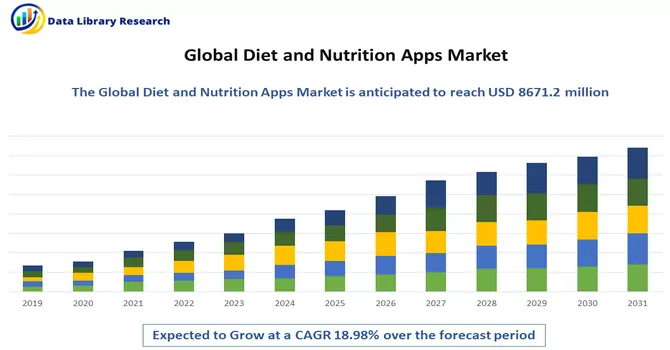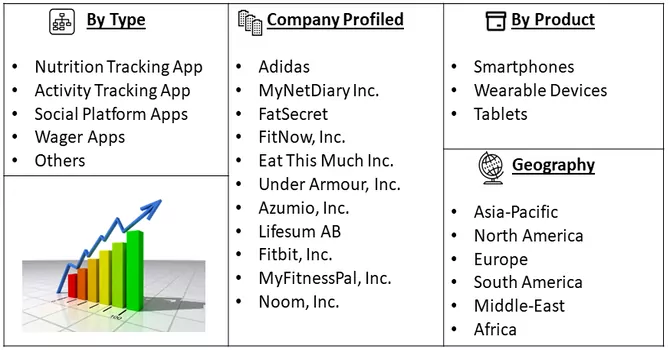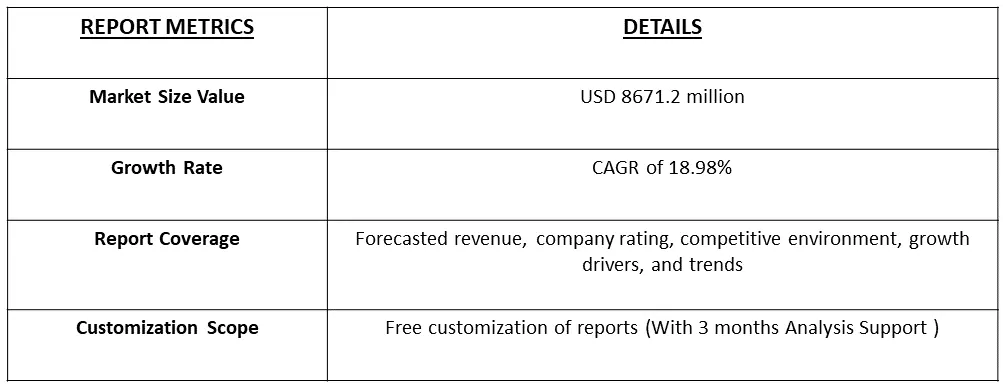The diet and nutrition apps market which was USD 8671.2 million in 2023, is likely to reach USD 37,380.2 million by 2031 and is expected to undergo a CAGR of 18.98% during the forecast period, 2023-2031.

Get Complete Analysis Of The Report - Download Free Sample PDF
Diet and nutrition apps are digital applications designed to assist individuals in managing their dietary habits, tracking nutritional intake, and promoting overall health and wellness. These apps typically offer features such as meal planning, calorie counting, food logging, and nutritional analysis. Users can input their dietary preferences, health goals, and personal information, and the apps provide personalized recommendations, meal suggestions, and tracking tools. Some diet and nutrition apps also incorporate features like fitness tracking, water intake monitoring, and educational resources on healthy eating. These applications leverage technology to provide convenient and accessible tools for individuals seeking to make informed choices about their diet, monitor their nutritional intake, and achieve specific health and wellness objectives.
The anticipated growth of the market in the forecast period is expected to be propelled by significant factors such as mergers and acquisitions, substantial investments in research and development initiatives, and the introduction of innovative features. Companies engaging in strategic mergers and acquisitions aim to enhance their market position and expand their capabilities. Simultaneously, major investments in research and development underscore a commitment to innovation and the advancement of cutting-edge technologies within the industry. Additionally, the continuous introduction of new features is poised to meet evolving consumer demands, ensuring sustained market growth by providing enhanced and diversified offerings to the target audience.
The Diet and Nutrition Apps market is experiencing dynamic trends, driven by a surge in health consciousness, increased daily active users, and the expanding online presence of wellness platforms, including gyms and studios. Technological integration, marked by the incorporation of machine learning and artificial intelligence, has resulted in more personalized programs, featuring individualized diet charts, workout routines, and health coaching. Mergers, acquisitions, and substantial investments in research and development are shaping the competitive landscape, emphasizing innovation and market positioning. The introduction of new features, such as enhanced tracking capabilities and clinical solutions for obesity management, underscores the market's evolution. Additionally, the integration of telehealth services reflects a broader approach to health management, making diet and nutrition apps comprehensive tools for users seeking personalized, convenient, and holistic solutions for their well-being.
Market Segmentation: The market is Segmented by Type (Nutrition Tracking App, Activity Tracking App, Social Platform Apps, Wager Apps, Others), Products (Smartphones, Wearable Devices, Tablets), and by Region (Africa, Asia-Pacific, Europe, Middle East, North America, and South America). Key data points observed include the market volume of end-user segments, per capita consumption, and raw material production.

For Detailed Market Segmentation - Download Free Sample PDF
Market Drivers:
Digital device and Internet penetration
The widespread penetration of digital devices and the increasing availability of the internet have significantly influenced the adoption and functionality of Diet and Nutrition apps. With a growing number of people owning smartphones, tablets, and other digital devices, coupled with expanded internet accessibility, these apps have gained unprecedented reach and popularity. Users can easily download and access diet and nutrition apps, empowering them to take control of their health through personalized dietary guidance, meal tracking, and fitness routines.i The prevalence of digital devices has facilitated seamless integration with these apps, allowing users to conveniently monitor their nutrition, access educational content, and receive real-time feedback. The internet serves as a conduit for the continuous update of app features, nutritional databases, and the latest health information. This connectivity enables users to stay informed about dietary trends, access personalized meal plans, and engage with a community of like-minded individuals for support and motivation. Moreover, the integration of wearable devices, which are often linked to diet and nutrition apps, leverages the capabilities of digital technology to provide real-time health data, including physical activity levels and biometrics. This interconnected ecosystem of digital devices and nutrition apps contributes to a comprehensive approach to health management, making it easier for users to align their dietary habits with their fitness goals. As digital device and internet penetration continue to grow globally, the Diet and Nutrition app market is poised for further expansion, offering increasingly sophisticated and user-friendly solutions to address the evolving health and wellness needs of a digitally connected population.
Growing health and Wellness Awareness
The escalating awareness of health and wellness is propelling the widespread adoption of nutrition apps, as individuals increasingly seek digital solutions to manage their dietary habits and overall well-being. These apps, offering personalized meal planning, calorie tracking, and nutritional insights, serve as integral tools in empowering users to make informed choices about their nutrition. Beyond basic features, many apps incorporate educational resources, mindfulness exercises, and community engagement, fostering a holistic approach to health management. As the connection between health consciousness and nutrition apps strengthens, these digital platforms are poised to play a pivotal role in promoting healthier lifestyles, preventive healthcare, and community-driven wellness initiatives.
Market Restraints:
Nutrient coding inconsistencies
The growth of the diet and nutrition app market may face challenges due to nutrient coding inconsistencies. Variations in nutrient databases and coding methods across different platforms can result in discrepancies in nutritional information provided by these apps. Users may encounter inconsistencies in calorie counts, macronutrient profiles, and other essential nutritional data, potentially leading to inaccurate dietary assessments. This lack of standardization poses a concern for the reliability and effectiveness of these apps, impacting user trust and hindering widespread adoption. To foster market growth, addressing and standardizing nutrient coding practices becomes imperative, ensuring that diet and nutrition apps deliver consistent and accurate information to users, promoting their efficacy and reliability in supporting healthy lifestyle choices.
The COVID-19 pandemic has heightened awareness of health and well-being, leading to a surge in daily active users on diet and nutrition apps from 2019 to 2020, according to various research papers. Simultaneously, the increased online presence of studios, wellness clubs, and gyms has further contributed to the growing adoption of these apps. Leveraging technologies like machine learning and artificial intelligence, diet and nutrition apps now offer personalized programs to users, including customized diet charts, no-equipment workout routines, and access to personalized health coaches. Additionally, these apps facilitate the tracking of footsteps and diet monitoring. These features contribute to the market's growth potential, exemplified by platforms like MyFitnessPal, which provides personalized diet and activity tracking services to its users.
Segmental Analysis:
Nutrition Tracking App Segment is Expected to Witness Significant Growth Over the Forecast Period
Nutrition tracking apps have become integral tools in promoting healthier lifestyles, offering users a convenient and personalized way to monitor their dietary habits. These apps typically feature user-friendly interfaces for logging meals, tracking calorie intake, and analyzing nutritional content. By providing real-time insights into macronutrient and micronutrient intake, they empower individuals to make informed choices about their diets. Many nutrition tracking apps also offer additional features such as goal setting, personalized meal plans, and integration with wearable devices, enhancing the overall user experience. As awareness of health and wellness continues to grow, these apps play a pivotal role in helping users achieve their nutritional goals and maintain a balanced and informed approach to their dietary well-being.
Smart Phone Segment is Expected to Witness Significant Growth Over the Forecast Period
Smartphones have become instrumental in transforming how individuals manage their dietary habits, with a plethora of diet and nutrition apps capitalizing on the convenience and accessibility of these devices. These apps, easily downloadable on smartphones, offer users personalized tools for tracking and analyzing their nutritional intake, fostering a proactive approach to health and wellness. From calorie counting and meal planning to monitoring macronutrient profiles, smartphones serve as portable nutrition hubs, providing users with instant insights into their dietary choices. The integration of features like barcode scanning, recipe analysis, and wearable device synchronization enhances the user experience, making it seamless for individuals to align their nutritional goals with their daily routines. As smartphones continue to be ubiquitous in daily life, the synergy between these devices and nutrition apps is shaping a more informed and health-conscious society.
Asia Pacific Region is Expected to Witness Significant Growth Over the Forecast Period
In the Asia Pacific region, the adoption of diet and nutrition apps is experiencing a notable upswing, driven by the increasing awareness of health and wellness among the population. As lifestyles evolve and digital connectivity proliferates, individuals in countries like China, India, Japan, and others are turning to these apps for personalized dietary guidance, meal planning, and fitness tracking. The prevalence of smartphones and improving internet accessibility in the region further accelerates the integration of diet and nutrition apps into daily routines. Recognizing diverse dietary preferences, cultural nuances, and health priorities, these apps often cater to specific regional needs, offering a range of features from traditional dietary guidance to innovative nutritional analysis. With the Asia Pacific population increasingly prioritizing preventive healthcare and holistic well-being, diet and nutrition apps are becoming pivotal tools in supporting individuals on their health journeys, contributing to the region's burgeoning digital health landscape.

Get Complete Analysis Of The Report - Download Free Sample PDF
The anticipated growth of the market in the forecast period is expected to be propelled by significant factors such as mergers and acquisitions, substantial investments in research and development initiatives, and the introduction of innovative features. Companies engaging in strategic mergers and acquisitions aim to enhance their market position and expand their capabilities. Simultaneously, major investments in research and development underscore a commitment to innovation and the advancement of cutting-edge technologies within the industry. Additionally, the continuous introduction of new features is poised to meet evolving consumer demands, ensuring sustained market growth by providing enhanced and diversified offerings to the target audience. Some of the prominent players in the U.K. and Germany diet and nutrition apps market include:
Recent Development:
1) In October 2023, HealthifyMe Wellness Pvt Ltd, the Indian subsidiary of the company, disclosed a standalone operating revenue of INR 228.7 crore, marking a significant upswing from the previous fiscal year's INR 185 crore, as per regulatory filings. This notable increase was primarily propelled by a 25% growth in nutrition and wellness coaching services, reaching INR 139 crore, compared to INR 111.6 crore in the preceding fiscal year.
2) In October 2023, Noom extended its services for employers by introducing Noom Med, a clinical obesity management solution. Unveiled at HLTH 2023 in Las Vegas, the program caters to individuals in need of additional clinical support in their weight loss journey. Noom Med offers access to clinicians and medications, including GLP-1s, thereby enhancing Noom's digital weight loss support platform. This strategic expansion underscores Noom's commitment to addressing diverse needs within the weight management sector and further solidifying its position in the market.
Q1. How Big is the Diet and Nutrition Apps Market?
As per Data Library Research the diet and nutrition apps market which was USD 8671.2 million in 2023, is likely to reach USD 37,380.2 million by 2031
Q2. At what CAGR is the Diet and Nutrition Apps market projected to grow within the forecast period?
Diet and Nutrition Apps market is expected to undergo a CAGR of 18.98% during the forecast period.
Q3. What are the Growth Drivers of the Diet and Nutrition Apps market?
Digital device and Internet penetration and Growing health and Wellness Awareness are the Growth Drivers of the Diet and Nutrition Apps market.
Q4. Who are the key players in Diet and Nutrition Apps market?
Some key players operating in the market include
Data Library Research are conducted by industry experts who offer insight on industry structure, market segmentations technology assessment and competitive landscape (CL), and penetration, as well as on emerging trends. Their analysis is based on primary interviews (~ 80%) and secondary research (~ 20%) as well as years of professional expertise in their respective industries. Adding to this, by analysing historical trends and current market positions, our analysts predict where the market will be headed for the next five years. Furthermore, the varying trends of segment & categories geographically presented are also studied and the estimated based on the primary & secondary research.
In this particular report from the supply side Data Library Research has conducted primary surveys (interviews) with the key level executives (VP, CEO’s, Marketing Director, Business Development Manager and SOFT) of the companies that active & prominent as well as the midsized organization
FIGURE 1: DLR RESEARH PROCESS

Extensive primary research was conducted to gain a deeper insight of the market and industry performance. The analysis is based on both primary and secondary research as well as years of professional expertise in the respective industries.
In addition to analysing current and historical trends, our analysts predict where the market is headed over the next five years.
It varies by segment for these categories geographically presented in the list of market tables. Speaking about this particular report we have conducted primary surveys (interviews) with the key level executives (VP, CEO’s, Marketing Director, Business Development Manager and many more) of the major players active in the market.
Secondary ResearchSecondary research was mainly used to collect and identify information useful for the extensive, technical, market-oriented, and Friend’s study of the Global Extra Neutral Alcohol. It was also used to obtain key information about major players, market classification and segmentation according to the industry trends, geographical markets, and developments related to the market and technology perspectives. For this study, analysts have gathered information from various credible sources, such as annual reports, sec filings, journals, white papers, SOFT presentations, and company web sites.
Market Size EstimationBoth, top-down and bottom-up approaches were used to estimate and validate the size of the Global market and to estimate the size of various other dependent submarkets in the overall Extra Neutral Alcohol. The key players in the market were identified through secondary research and their market contributions in the respective geographies were determined through primary and secondary research.
Forecast Model
